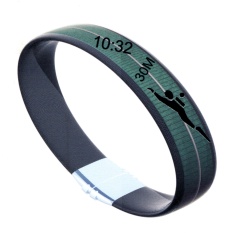In 2012, Nike registered successfully a Community Design for an electronic wristband. One year later, Mr. Murphy filed for a declaration of invalidity of Nike’s design on the basis of a prior registered design for “Flexible LCD watch bands”.


Mr. Murphy argued that Nike design infringed Article 6(1)(b) of the Community Designs Regulation, submitting that it lacked individual character as the overall impression on the informed user did not differ from that produced by Murphy’s prior design.
Neither the Invalidity Division of the EU Intellectual Property Office (EUIPO) nor the EUIPO Board of Appeal agreed with Mr. Murphy.
The case came before the EU General Court upon Mr. Murphy’s appeal of the Board of Appeal decision.
The General Court rejected Murphy’s application for a declaration of invalidity of the Nike design on the following grounds (here).
Firstly, it considered that, in order for a wristband to be able to fulfil its function properly, its designers would be limited by several constraints, as the need to be relatively small, thin, light, ergonomic in order to fit the wrist and to contain measuring instruments. These technical constraints led to conclude that the degree of freedom of the designer was high rather than very high, as argued by Mr. Murphy.
The degree of freedom must be taken into consideration in assessing individual character pursuant to Article 6(2) of the Designs Regulation, because the more the freedom of the designer in developing a design is restricted, the more likely it is that minor differences between the designs being compared will be sufficient to produce a different overall impression on an informed user. (see judgment of 10 September 2015, Handbags, T‑525/13, EU:T:2015:617, paragraph 29 and the case-law cited).
In any case, even taking account of a high degree of freedom afforded to the designer of electronic wristbands, the Court reiterated the position from earlier case law that the overall impression produced by the Nike design on the informed user was clearly different to that produced by Murphy’s design.
Indeed there were a number of differences between the two designs, namely that (i) the Nike design was larger and thicker than Murphy’s design, (ii) Nike’s design featured a large oval button on the surface of the wristband which was not present in Murphy’s design, (iii) the internal components of the Nike design were visible, giving it a more technical aspect than Murphy’s design, which appeared as opaque and elegant, and (iv) the Nike design had less ornamentation than Murphy’s design, on which the image of a diver and a line running along the wristband were clearly visible.
On the contrary, the clasps’ similarity in both designs alone was not sufficient to make them similar as a whole. Indeed, the overall impression must be determined in light of the manner in which the product is used and when using an electronic wristband, the informed user attaches more importance to the part displaying the data than to the clasp.
The General Court disregarded Murphy’s argument, based on UK case law, that his prior design enjoyed a higher degree of protection because it was a significant advance over the prior art in existence at the time of its registration in 2005. The Court has pointed out that it was not bound to consider decisions of national courts, even where the latter are based on provisions analogous to those of that regulation (see judgment of 29 October 2015, Éditions Quo Vadis v OHIM — Gómez Hernández (‘QUO VADIS’), T‑517/13, not published, EU:T:2015:816, paragraph 46 and the case-law cited). In addition, the new and unusual character of Murphy’s design did not prevent the informed user from perceiving the differences in subsequent designs (see, to that effect, judgment of 21 May 2015, Senz Technologies v OHIM — Impliva (Umbrellas), T‑22/13 and T‑23/13, EU:T:2015:310, paragraph 95).
Appeal has already been brought before the European Court of Justice (ECJ) (C-538/17 P). It does not seem unreasonable to predict the confirmation of the here mentioned decision. Indeed, the General Court seems to have applied the long standing principles formulated by the ECJ in relation to the assessment of the individual character and its judgment appears to be a matter of fact, that hardly may be challenged by the higher court.
Jacopo Ciani
General Court (Fifth Chamber), 4 July 2017, Thomas Murphy v European Union Intellectual Property Office, Case T-90/16

When he states in (iv) that ” the Nike design had less ornamentation than Murphy’s design, on which the image of a diver and a line running along the wristband were clearly visible”.
Mr Jacopo Ciani has clearly been misinformed and has thus failed to realise
(1) that back in 2004 when Mr Murphy made his application for an electronic bracelet he did not apply for ornamentation (what is seen on his design is the example of a screen content when the screen is switched on).
(2) Furthermore, the title of Mr Murphy’s application does not stipulate the word “ornamentation”. As mentioned before “ornamentation” was not claimed in his application.
(3) this brings us to Mr Ciani’s next comment that of the “the clasps’ similarity in both designs” and the “manner in which the product is used and when using an electronic wristband, the informed user attaches more importance to the part displaying the data than to the clasp”. Given (1) and (2) above Mr Ciani and a properly informed user will now be aware that Mr Murphy electronic screen display area is of great importance to understand the design and the type of information a screen can contain, not to mention the relevance of the clap in facilitating such contents’ displays.
It would be nice of Mr Ciani to review his comments in the light of this new information. The first thing EUIPO and the EU courts should have done in the case of Mr Murphy’s application for Invalidation of the Nike design was to check his 2004 application document which clearly documents the extent of his prior art (as a Plato FIRST FORM it should clearly deserve more protection and they should have procured him a protection in direct proportion with the level of novelty of his design). I trust that if he had wanted to make a claim for ornamentation the word “ornamentation” would also be prominent in the title. When the word “ornamentation” is not used in the title it would be erroneous to make comments relating to “ornamentation”. All judging parties and the informed user should be made aware of this. Mr Murphy’s electronic bracelets shape was as novel in 2004 as a FIRST FORM.
When the screen is switched off both Mr Ciani and the informed user would not doubt be aware of the simplicity of Mr Murphy’s design and understand why Mr Murphy applied for the invalidation of the Nike Fuelband+ design which encompasses both the screen simplicity, the shape and the electronic closer, in other words the concrete aesthetic plus value of Mr Murphy’s electronic screen design.
LikeLike
[…] Creating and maintaining Telegram channels is quite a profitable business if you approach it with full responsibility and follow a clear strategy for the resource development. At the moment, there is no other more promising platform for the informational content, so every talented author should spend time to develop their channel in this messenger.channel telegram list […]
LikeLike
The General Court established a “try luck” judgement prima facie without verifying the credibility of any of the pleas made by the Office/Nike; focusing their judgement on “immaterial” details and carefully avoiding the most obvious one, which is the design, which integrates flexed circuits technology and a closer as ONE within its corpus.
The integration of such flexible technology in the Murphy design is very novel in 2004 and the design shape (unaccounted for by the courts, ) is possible only because of the use of such flexible electronic circuits technology. Furthermore the integrated closer is also connected to the flexible technology. The integrated closer, the flexible technology and the flexible bracelet design corpus should have been understood as the novel key elements of the Murphy design and the reason for wanting to invalidate the Nike design which also integrated flexible technology in a band with an integrated closer. Readers may have noted that the word “matrix” and “flexible” were carefully averted by all courts, although matrixes are evident in both representations and both bands integrate flexible elements.
Technical wrist constraints for “measuring devices” were imposed for both RCDs by the Board of Appeal ‘the degree of freedom of the designer is basically only limited by the technical constrains applicable to such wristbands (…)’. First of all I am not aware that the wrist is a constraining factor to read electronic information which in 2012 could be divulged by iphone. Secondly, it is quite obvious that in 2012 flexible electronics or even flat matrixes could be set on supports of varied shapes on diverse body parts (N.B. An informed user aware of previous Nike measuring devices would have known that, however this one didn’t).
The Nike button evidently did not have to be set on a flexed electronic band design with integrated closer (did any of the previous Nike designs for measuring devices look like this? Does the integration of flexed electronics in the Nike bracelet not disturb the individual character and the novelty element of the Murphy bracelet (with eight years prior art). It is true that the introduction of matrixes in flexible electronic technology creates a huge difference when it comes to fitting flexed circuits inside a bracelet band. Should no one have queried why such a button was made land so conspicuously on a flexible band with an integrated closer. Does the button make the shape or does the shape make the button? Why not purchase the RCD or license it so as to be able to place the button without constrains?
Why can a design not be invalidated if it uses a button and transparency to take over a prior art design? Can transparency be registered as RCD? Can transparency, used decoratively to expose underlying flexible circuits functionality integrated to a closer, be registered if a shape integrating flexible circuits functionality linked to a closer was previously protected as prior art, the flexible electronic attribute of which having already been endorsed for their novelty and individual character as prior art?
Whereas all the immaterial differences did not escape the informed user’s attention one wonders why it should be that the most obvious characteristic common to both designs would have evaded the “particularly observant” user described by EUIPO.
Although the EUIPO response states that “There is no reason to presume that a user confronted with two new and unusual designs is not able to perceive differences between them solely because certain characteristic features of those designs are the same for both” , it never mentions the obvious feature of flexed electronics and closer unobserved by the user.
It is sad to think that Mr Murphy’s lawyers’ pleas could not be heard because, as clarified by EUIPO,” the Board of Appeal was not required to address each of the arguments raised by the Applicant”
I should be glad if someone could explain why the EUIPO contends: “whether a contested RCD violates earlier rights is irrelevant in the context of an application for a declaration of invalidity before the Office”…
Although I am a neophyte in the field of law and design protection I believe in logic and facts. I would greatly appreciate it if someone could dichotomise the elements of this case for me. In simple words.
Laurence Murphy
LikeLike